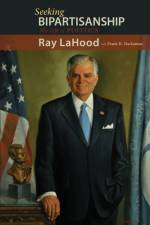av Ray LaHood
417
The twenty years since 1995 have seen their share of landmark events. Among them a contested presidential election result (2000), a terrorist attack on U.S. soil (2001), the beginning of a war in Iraq (2003), economic calamity (2008), the election and reelection of the nation s first African American president (2008, 2012), two changes in party control of the presidency, three changes in party control of the House (including the first Republican majority in 40 years as a result of the 1994 congressional elections), and five changes in party control of the Senate. Throughout these volatile times, one theme stands out: political polarization has characterized American politics, creating gridlock in Washington and breeding distrust of government among the nation s citizens. Evidence of polarization abounds. The Pew Research Center found substantial overlap in Congress between liberal Republicans and conservative Democrats in the 1970s. Those days are gone. By the 2011-2012 congressional term, the common ground had melted away the most liberal Republican was more conservative than the most conservative Democrat. Moreover, the partisan divide reflects polarization throughout the country. A 2014 poll of 10,000 adults found that Republicans and Democrats are further apart ideologically than at any point in recent history. The harm to our politics can be measured in the negative attitudes Americans hold about our governing institutions. In early 2015, more people disapproved (51.5 percent) of President Obama s performance than approved (44.0 percent). The news was worse for Congress. More than 72 percent of those polled disapproved of the job Congress was doing. Taken together, the presidential and congressional job ratings help explain why 60 percent believed the country was on the wrong track. Few first-hand accounts from those who witnessed and participated in these events currently exist. Their experiences and evaluations of trends and events, however, not only help us understand the dynamics and impact of partisanship over two decades but also suggest possible remedies. This book provides a personal perspective from one of a very few individuals who served both in Congress and in a presidential Cabinet during these tumultuous times. LaHood s account covers his 14 years in Congress with 10 chapters centered on four pivotal events. The first relates to the Gingrich Revolution when Republicans seized control of the House in 1995. As a former staffer to House Republican leader Robert H. Michel, LaHood occupied a unique vantage point as his party won and eventually lost their majority amidst the intrigue of intraparty leadership battles and increasing confrontation between the two political parties. The second series of events deals directly with the decline of civility in the House which accompanied the rise in acrimonious partisanship. LaHood organized and led four House retreats in an ultimately unsuccessful effort to understand the causes of, and remedies for, the increasingly dysfunctional conduct of the House s business. The lessons learned then about the prospects for promoting change in the culture of Congress remain current. The third defining episode: LaHood presided during House debate over President Bill Clinton s impeachment in 1998. His story also includes details on the collapse of the House Republican leadership in that period. The fourth event relates to Congress s investigation of 9/11 during which LaHood sat on the House Permanent Select Committee on Intelligence. As the only elected Republican selected for President Obama s Cabinet, LaHood sought to bridge the partisan divide between the new Democratic administration and Republicans on Capitol Hill. It proved to be a struggle compounded by the president s governing style and Republican intransigence. President Obama s promise to govern in a bipartisan manner went unrealized, in spite of his attempts, for reasons LaHood addresses in this book. The book includes reproductions of White House photographs and archival materials.

